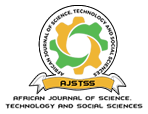SwaRegex: a lexical transducer for the morphological segmentation of swahili verbs
DOI:
https://doi.org/10.58506/ajstss.v1i2.119Keywords:
Natural Language Processing (NLP), Morphological segmentation, Low resource language, Lemmatization, Speech taggingAbstract
The morphological syntax of the Swahili verb comprises 10 slots. In this work, we present SwaRegex, a novel rule-based model for the morphological segmentation of Swahili verbs. This model is designed as a lexical transducer, which accepts a verb as an input string and outputs the morphological slot occupied by the morphemes in the input string. SwaRegex is based on regular expressions developed using the C# programming language. To test the model, we designed a web scraper that obtained verbs from an online Swahili dictionary. The scrapper separated the corpus into two datasets: dataset A, comprising 163 verbs Bantu origin; and dataset B, containing the entire set of 715 non-Arabic verb entries obtained by the web scrapper. The performance of the model was tested against a similar model designed using the Xerox Finite State Tools (XFST). The regular expressions used in both models were the same. SwaRegex outperformed the XFST model on both datasets, achieving a 98.77% accuracy on dataset A, better than the XFST model by 41.1%, and a 68.67% accuracy on dataset B, better than the XFST model by 38.46%. This work is beneficial to prospective learners of Swahili, by helping them understand the syntax of Swahili verbs, and is an integral teaching aid for Swahili. Search engines will benefit from the lexical transducer by leveraging its finite state network when lemmatizing search terms. This work will also create more opportunities for more research to be done on Swahili.


